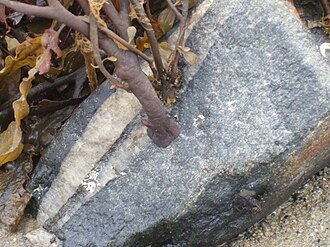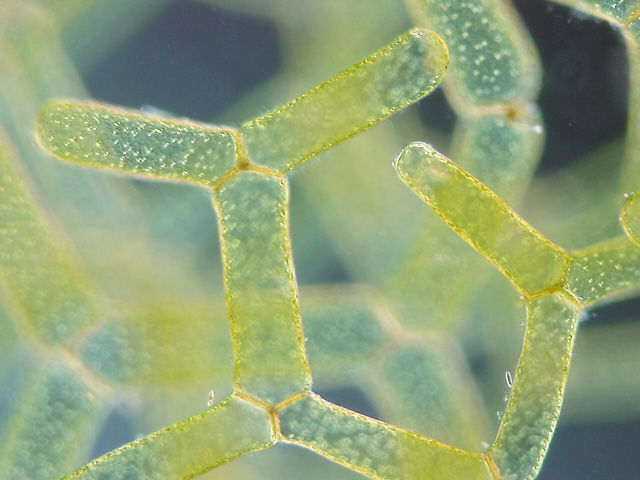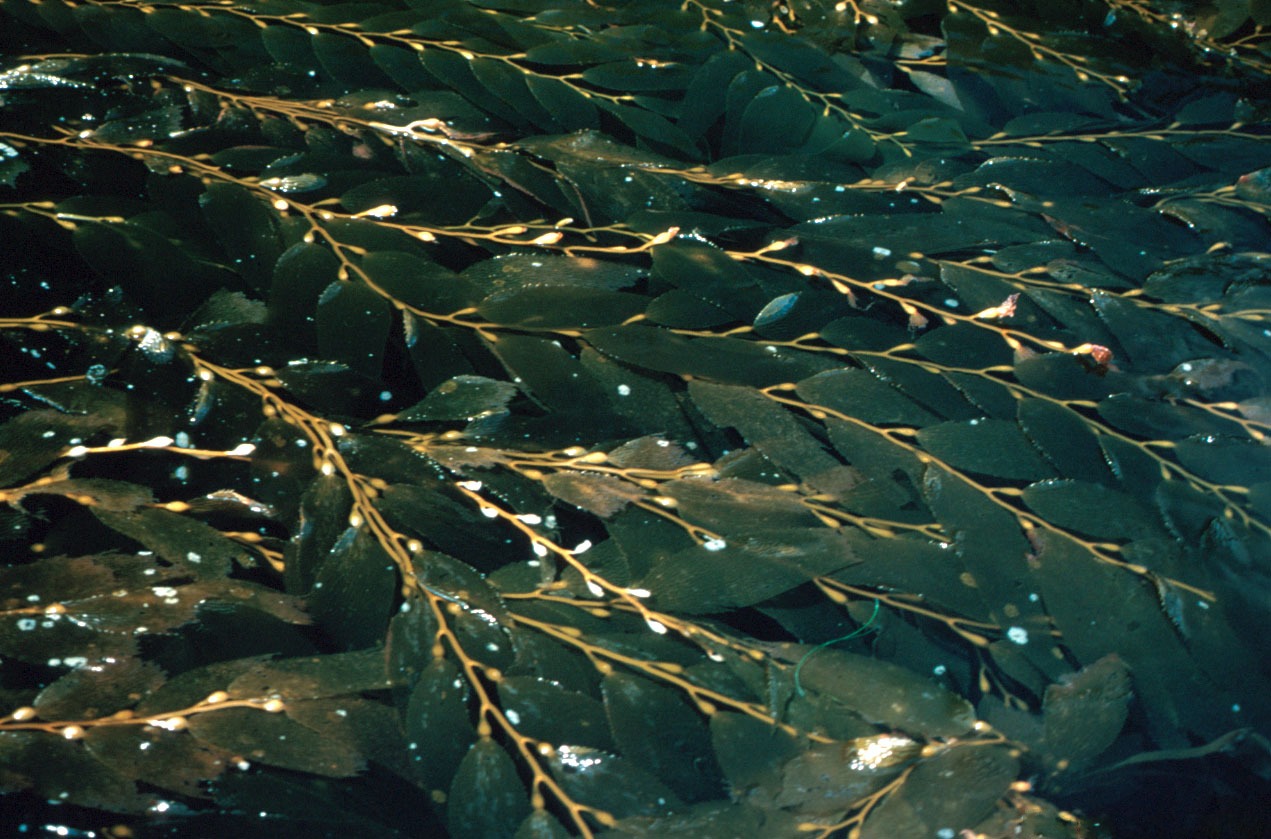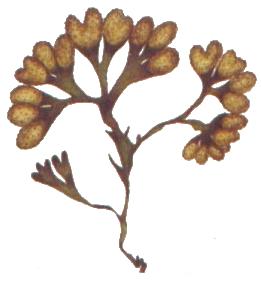Difference between revisions of "AY Honors/Marine Algae/Answer Key/es"
(Created page with "{{Species id | latin_name = Sargassum muticum | color = tan | image = Sargassum weeds closeup.jpg | image_caption = Sargassum de cerca | description = primary lateral branches...") |
|||
| Line 104: | Line 104: | ||
{{Species id | {{Species id | ||
| + | | common_name = | ||
| latin_name = Codium | | latin_name = Codium | ||
| color = lightgreen | | color = lightgreen | ||
| Line 109: | Line 110: | ||
| image_caption = ''Codium frágil'' | | image_caption = ''Codium frágil'' | ||
| range = | | range = | ||
| − | | | + | | Descripción = El género tiene talos de dos formas, erecto o postrado. Las plantas erectas son dicotómicamente ramificadas a 40 cm de largo con ramas que forman una estructura esponjosa compacto, no calcárea. Las ramas finales forman una capa superficial y estrecha de corteza empalizada de utrículos. Las especies que no son erguidas forman un postrado o un talo globular con una superficie aterciopelada, las ramas finales formando una estrecha corteza de utrículos. |
}} | }} | ||
Revision as of 03:49, 7 October 2014
| Algas Marinas | ||
|---|---|---|
| Asociación General
|
Destreza: 3 Año de introducción: 1961 |
|
Requisitos
1. ¿Qué es una alga marina?
Las algas marinas son popularmente descritas como plantas, pero los biólogos no las consideran como plantas (en biología, todas las plantas verdaderas pertenecen al reino Plantae). No deben confundirse con las plantas acuáticas como los pastos marinos (que son plantas vasculares).
2. ¿Dónde se encuentra?
Las algas marinas se encuentran principalmente en el océano en poca profundidad, cerca de las costas rocosas. También se encuentran en el agua dulce, tales como estanques, lagos y ríos.
3. What is the organ of attachment to the substratum called? How does it differ from a true root?
The organ that attaches a marine algae to a substrate is called a "holdfast". Unlike a root, a holdfast derives no nutrients from this intimate contact with the substrate.
Holdfasts vary in shape and form depending on both the species and the substrate type. The holdfasts of organisms that live in muddy substrates often have complex tangles of root-like growths, while those of organisms that live in sandy substrates are bulb-like and very flexible, such as the holdfast of sea pens, allowing the organism(s) to pull the entire body into the substrate when the holdfast is contracted. The holdfasts of organisms that live on smooth surfaces (such as the surface of a boulder) have the base of the holdfast literally glued to the surface.
4. ¿Cómo varían en tamaño las algas marinas?
Algunas algas marinas son tan pequeñas que sólo se pueden ver con un microscopio. Otras son muy grandes, tales como Macrocystis, una especie de alga que pertenece al grupo de algas de color marrón, que puede alcanzar 60 metros de longitud.
5. Nombrar los 4 grupos de algas marinas, indicando junto al nombre de cada grupo si es unicelular, multicelular o ambas.
| Grupo | Unicelular | Pluricelular |
|---|---|---|
| Alga Roja | ||
| Alga Parda | ||
| Alga Verde | ||
| Diatomeas |
6. ¿En dónde se encuentran más algas verdes, en agua dulce o salada?
Mientras que un 90% de las especies de algas verdes viven en hábitats de agua dulce y la mayoría de los otros 10% viven en los hábitats marinos, otras especies se adaptan a una amplia gama de entornos. Chlamydomonas nivalis, de la clase Chlorophyceae, vive en campos de nieve alpinos de verano. Otros viven adjuntas a rocas o partes leñosas de árboles. Algunos líquenes son relaciones simbióticas con hongos y un alga verde.
7. ¿Qué son diatomeas?
Las diatomeas son un grupo importante de algas y son uno de las clases más comunes de fitoplancton. La mayoría de las diatomeas son unicelulares, aunque algunas forman cadenas o colonias simples. Una característica de las células de la diatomea es que están rodeadas dentro de una pared celular única hecha de sílice (dióxido de silicio hidratado) llamada frústula. Estas frústulas muestran una diversidad amplia de formaa, algunas muy hermosas y adornadas, pero consisten generalmente de dos lados asimétricos con una fractura entre ellos, de ahí el nombre del grupo.
Las diatomeas son un grupo amplio y se pueden encontrar en los océanos, en agua dulce, en la tierra y en las superficies húmedas. La mayoría viven en aguas abiertas, aunque algunos viven en las capas superficiales de la interfase agua-sedimento, o incluso en condiciones atmosféricas húmedas. Son especialmente importantes en los océanos, donde se estima que contribuyen hasta un 45% de la base de la cadena alimentaria oceánica.
8. ¿Dónde crecen las algas más fácil: en las zonas polares, templadas o tropicales?
Las algas crecen en todas estas zonas, desde picobilifitas, que son un alga autóctona de las regiones polares, a sargazo, que vive en las aguas tropicales del Océano Atlántico.
9. ¿Dónde se encuentran la mayoría de las algas pardas invariablemente, en agua dulce o salada?
Las algas pardas se encuentran en la mayoría de los ecosistemas de agua salada.
10. ¿Cuál es la mayor profundidad en los océanos donde las algas crecen? ¿Por qué no puede crecer en agua más profunda?
La algas que viven en lo más profundo son aquellos que están unidos a los fondos marinos bajo varios metros de agua. El factor limitante en estos casos es la disponibilidad de suficiente luz solar para apoyar la fotosíntesis. Las algas que viven en lo más profundo son las diversas algas pardas.
11. Nombrar las 3 partes de las grandes algas pardas (kelp). ¿Cómo se comparan ellas con la hoja, tallo y raíz de una planta?
- Hoja
- La hoja es una estructura grande y plana, y es análoga a las hojas de una planta.
- Estipe
- El estipe sirve como un vástago al cual se unen las hojas.
- Rizoide
- El rizoide es la parte de la planta que lo ancla a un sustrato, tal como una roca o el suelo marino. Es análogo a la raíz de una planta.
12. Describir las 2 maneras en que se reproducen las algas.
Reproducción Sexual
La mayoría de las formas de algas se reproducen sexualmente mediante la formación de esporas. Las esporas, cuando se desechan el organismo adulto, se convierten en gametos masculinos y femeninos que llevan sólo la mitad de la información genética del organismo progenitor. Estos gametos son móviles, lo que significa que pueden moverse por sí mismos, propulsados por pequeños flagelos. Cuando los gametos masculinos y femeninos de la misma o de diferentes organismos parientes combinan, el material genético se fusiona para crear un organismo con un complemento completo de material genético. Esto es muy similar a la forma en que se reproducen los helechos (véase la especialidad Ferns para más detalles).
Reproducción Asexual
La reproducción asexual es ventajoso ya que permite aumentos de la población eficientes, pero menos variación es posible. La reproducción sexual permite más variación pero es más costosa debido a la pérdida de gametos que fallan para aparearse, entre otras cosas. A menudo no hay alternancia estricta entre las fases esporofito y gametofito y también porque a menudo hay una fase asexual, que podría incluir la fragmentación del talo.
13. What are some of the commercial values of algae? Give at least one for each group.
- Food
- Most cultures with access to Porphyra, a genus of red algae use it as a food or somehow in the diet, making it perhaps the most domesticated of the marine algae.
- Emulsifier
- Gelatinous extracts of carrageen seaweed (also known as Irish moss, a red algae) have been used as food additives for hundreds of year. It acts as an emulsifier, which is to say, it help combine items which resist combination, such as oil and water. It is commonly used in toothpaste, ice cream, milkshakes, sauces, and even shampoo (which we admit is not a food).
- Fertilizer
- Seaweed, particularly bladderwrack, kelp or laminaria (which are all forms of brown algae), can be either applied to the soil as a mulch (although it will tend to break down very quickly) or can be added to the compost heap, where it is an excellent activator.
- Medicine
- Laminaria (a genus of brown algae) is used in the production of potassium chloride and iodine. Dried laminaria sticks can be used medicinally to induce dilation of the cervix. An additional medicinal use of algae is the product agar which is used as a culture medium for growing bacteria in laboratory settings.
- Pigments
- The natural pigments produced by algae can be used as an alternative to chemical dyes and coloring agents. Many of the paper products used today are not recyclable because of the chemical inks that they use, paper recyclers have found that inks made from algae are much easier to break down. There is also much interest in the food industry into replacing the coloring agents that are currently used with coloring derived from algal pigments. In Israel, a species of green algae is grown in water tanks, then exposed to direct sunlight and heat which causes it to become bright red in color. It is then harvested and used as a natural pigment for foods such as Salmon.
14. Make a collection of at least twenty specimen of marine algae properly identified, mounted, and labeled. There must be at least four specimens from the Green group, eight from the Brown group, and eight from the Red group.
The best approach for meeting this requirement is to obtain a field guide to algae, go out to a beach, and collect the various types you find. Once you have a specimen, use the field guide to try to identify it. Continue collecting until you have at least 20 specimens you can identify, being absolutely sure to remove any animals living in the algae before you leave the area. You can collect the specimens in a bucket or keep them in plastic bags.
You will need to start the drying process right away. For this you will need:
- A shallow tray (such as from a cafeteria, or a cookie sheet)
- Mounting paper (herbarium paper or drawing paper)
- Wax paper
- Mailing labels or strips of paper
- Newspaper or blotter paper
- Two small pieces of plywood
- Nylon straps or belts, or C clamps
Follow this procedure:
- Rinse the alga to remove salt, sand and foreign particles.
- place one of the small pieces of plywood on a work surface and cover it with a layer of blotter paper (or newspaper).
- Fill the shallow pan with water and float the mounting paper in it.
- Float the algae specimen on the mounting paper, spreading the fronds out as best you can.
- Carefully lift the mounting paper with the algae specimen out of the water, draining off the water as you lift it up.
- Lay the mounting paper on the blotter paper placed on the sheet of plywood earlier.
- Cover the sample (still on the mounting paper) with a sheet of wax paper
- Put your name and the specimen's identity on the mailing label, and place it on the wax paper.
- Cover this with another layer of blotter paper and/or newspaper.
- Repeat for each sample, stacking them on atop the other, separated by blotters.
- When the last specimen has been covered, lay the second piece of plywood over assembly.
- Bind the "sandwich" with the nylon straps or belts, and tighten as best you can. Alternately, you could use C-clamps to clamp the sandwich together, or you could place heavy weights on the entire assembly.
- Place in a well-ventilated area
- Change the newspaper and blotter paper daily for the next five days or until the samples are dry.
Many types of algae have natural adhesives in them that will cause them to stick to the mounting paper all by themselves. For those that do not, a small dot of white glue may be used to affix them to the mounting paper. Label with the information collected about the specimen.
15. Ser capaz de identificar por nombre genérico, como mínimo, 10 clases de algas marinas.
(Codium)
{{{common_name}}} (Hydrodictyon reticulatum)
Descripción: A veces llamado red de agua, tiene una forma que parece como un saco hueco en forma de red. Puede crecer hasta varios decímetros.
{{{common_name}}} (Pediastrum simplex)
Descripción: El nombre Pediastrum significa "estrella normal", porque esta alga tiene forma de estrella. Se puede encontrar en muchos estanques, haciendo que el agua aparezca verdosa.
{{{common_name}}} (Volvox aureus)
Dónde se encuentra: Volvox is found in ponds and ditches, and even in shallow puddles. The most favorable place to look for it is in the deeper ponds, lagoons, and ditches which receive an abundance of rain water. It has been said that where you find Lemna, you are likely to find Volvox; and it is true that such water is favorable, but the shading is unfavorable. Volvox se encuentra en estanques y zanjas, y hasta en charcos de poca profundidad. El lugar mejor para buscar es en los más profundos estanques, lagunas y acequias que reciben una gran cantidad de lluvia. Se ha dicho que cuando se encuentra Lemna, es probable encontrar Volvox; y es cierto que dicha agua es favorable, pero el sombreado es desfavorable.
Descripción: The cells swim in a coordinated fashion, with a distinct anterior and posterior - or since Volvox resembles a little planet, a 'north and south' pole. The cells have eyespots, more developed near the anterior, which enables the colony to swim towards light. Volvox es uno de los clorofitos más conocidos y es el más desarrollado en una serie de géneros que forman colonias esféricas. Cada Volvox se compone de numerosas células flageladas similares a Chlamydomonas, del orden de 1000-3000 en total, interconectadas y arregladas en una esfera llena de glicoproteína (coenobium). Las células nadan de manera coordinada, con una anterior y posterior distinto - o, como Volvox se asemeja a un pequeño planeta, un polo 'norte y sur'. Las células tienen manchas oculares, más desarrollados cerca de la anterior, que permite a la colonia a nadar hacia la luz.
Alga Parda
{{{common_name}}} (Sargassum muticum)
Descripción: primary lateral branches grow from this stipe. In warm waters it can grow to 12 m long, however in British waters it grows to no more than 4 m long. The holdfast gives rise to a single main axis with secondary and tertiary branches which are shed annually. Numerous small 2-6 mm stalked air vesicules provide buoyancy. The reproductive receptacles are also stalked and develop in the axils of leafy laminae. It is self fertile. Muticum Sargassum es una alga parda grande de la clase Phaeophyceae. Crece unido a las rocas por un rizoide perenne de hasta 5 cm de diámetro. A partir de este rizoide el eje principal crece hasta un máximo de 5 cm de altura. Las láminas parecidas a hojas y ramas laterales primarias crecen de esta estípite. En aguas cálidas puede crecer hasta 12 metros de largo. Sin embargo, en aguas británicas crece a no más de 4 metros de largo. El rizoide da lugar a un único eje principal con ramas secundarias y terciarias que son vertidas anualmente. Numerosas pequeñas vesículas acechadas de aire de 2.6 mm proporcionan flotabilidad. Los receptáculos reproductivos también son acosadas y se desarrollan en las axilas de las láminas. Es auto fértil.
Kelp (Macrocystis)
Descripción: Macrocystis is a genus of kelp, some species of which are so huge that the plants may grow to up to 60m. The stipes arise from a holdfast and branch three or four times from near the base. Blades develop at irregular intervals along the stipe. M. pyrifera grows to over 45 m long. The stipes are unbranched and each has a gas bladder at its base.
Peacocks tail (Padina pavonica)
Descripción: Padina pavonica, commonly known as Peacocks tail, is a brown alga found in Atlantic Ocean. It is known to act as an elastin precursor when applied topically, signaling collagen production in the skin, thereby increasing the skin's elasticity.
Spiral wrack, Flat wrack (Fucus spiralis)
Descripción: Fucus spiralis is olive brown in color and similar to Fucus vesiculosus and Fucus serratus. It grows to about 30 cm long and branches somewhat irregularly. It attached by a discoid holdfast. The flattened blade has a distinct midrib and is usually spirally twisted without a serrated edge, as are to be seen in Fucus serratus, and it does not show air-vesicles, as is Fucus vesiculosus.
Bladder wrack (Fucus vesiculosus)
Dónde se encuentra: Fucus vesiculosus is one of the most common algae on the shores of the British Isles. It is recorded from the Atlantic shores of Europe, the Baltic Sea, Greenland, Azores, Canary Islands and Madeira. It also appears on the Atlantic coast of North America from Ellesmere Island, Hudson Bay to North Carolina.
Descripción: Fucus vesiculosus is a very variable alga. It can grow to 100 cm or more and is easily recognized by the small gas–filled vesicles which occur in pairs on either side of a central midrib running along the center of the strap-like frond. It was the original source of iodine, discovered in 1811, and was used extensively to treat goiter, a swelling of the thyroid gland related to iodine deficiency. A common food in Japan, bladder wrack is used as an additive and flavoring in various food products in Europe. Bladder wrack is commonly found as a component of kelp tablets or powders used as nutritional supplements. It is sometimes loosely called "kelp", but that term technically refers to a different seaweed.
Toothed wrack, Serrated wrack (Fucus serratus)
Descripción: Fucus serratus is a seaweed of the north Atlantic Ocean, known as toothed wrack or serrated wrack. It is olive–brown and similar to F. vesiculosus and Fucus spiralis. It grows from a discoid holdfast. The fronds are flat, about 2 cm wide, bifurcating, and up to 1 m long including a short stipe. The flattened blade has a distinct midrib and is readily distinguished from related taxa by the serrated edge of the fronds. It does not have air vesicles, such as are found in F. vesiculosus, nor is it spirally twisted like F. spiralis.

Two fronds of Laminaria digitata washed up on the foreshore of Anglesey, Wales, UK; background is mostly Ascophyllum nodosum. Ascophyllum nodosum
Knotted wrack, Egg wrack (Ascophyllum nodosum)
Dónde se encuentra: It is common on the northwestern coast of Europe (from Svalbard to Portugal) including east Greenland [1] and the northeastern coast of North America.
Descripción: Ascophyllum nodosum is an edible seaweed of the northern Atlantic Ocean. Ascophyllum nodosum has long fronds with large egg-shaped air-bladders set in the fronds at regular intervals and not stalked. The fronds can reach 2 m in length. They are attached by a holdfast to rocks and boulders. The fronds are olive-brown in color and somewhat compressed but without a mid-rib. This seaweed grows quite slowly and can live for several decades; it may take approximately five years before becoming fertile.
Red Algae
Irish moss (Chondrus crispus)
Dónde se encuentra: Chondrus crispus grows abundantly along the rocky parts of the Atlantic coast of Europe and North America. It can also be found in the Northern Pacific Ocean and parts of the Mediterranean.
Descripción: Chondrus crispus is a relatively small red algae little more than 20cms long growing from a discoid holdfast and branching in a dichotomous, fan-like, manner four or five times. The morphology is very variable, especially the broadness of the thalli. The branches are 2 - 15 mm broad, firm in texture and dark reddish brown in color bleaching to yellowish in sunlight. In its fresh condition the plant is soft and cartilaginous, varying in color from a greenish-yellow to a dark purple or purplish-brown; but when washed and sun-dried for preservation it has a yellowish translucent horn-like aspect and consistency. The principal constituent of Irish moss is a mucilaginous body, of which it contains about 55%; the plant also has nearly 10% of protein and about 15% of mineral matter, and is rich in iodine and sulphur. When softened in water it has a sea-like odour, and because of the abundant mucilage it will form a jelly when boiled, containing from 20 to 30 times its weight of water. Irish moss is a major source of carrageenan, which is commonly used as a thickener and stabilizer in milk products such as ice cream and processed foods.
Nori (Porphyra)
Descripción: Porphyra is a foliose red algal genus of laver, comprising approximately 70 species. It grows in the intertidal, typically between the upper intertidal to the splash zone. In East Asia, is used to produce the sea vegetable products nori (in Japan) and gim (in Korea), the most commonly eaten seaweed. It is considered that there are 60 to 70 species of Porphyra worldwide and seven in the British Isles.
Referencias
- Seaweed Lady on Flickr tiene muchas fotos de varias algas marinas.
- http://www.csd509j.net/cvhs/berand/Marine2007-2008/Labs/Student%20Pressing%20Algae%20Lab.doc - información en secar y montar algas marinas (sólo disponible en inglés)
- Categoría: Tiene imagen de insignia
- Adventist Youth Honors Answer Book/Honors/es
- Adventist Youth Honors Answer Book/es
- Adventist Youth Honors Answer Book/Skill Level 3/es
- Categoría: Libro de respuestas de especialidades JA/Especialidades introducidas en 1961
- Adventist Youth Honors Answer Book/General Conference/es
- Adventist Youth Honors Answer Book/Unknown/es
- Adventist Youth Honors Answer Book/Unknown/Primary/es
- Adventist Youth Honors Answer Book/Stage 0/es
- Categoría:Especialidades JA/Identificación de especie
- Adventist Youth Honors Answer Book/Completed Honors














